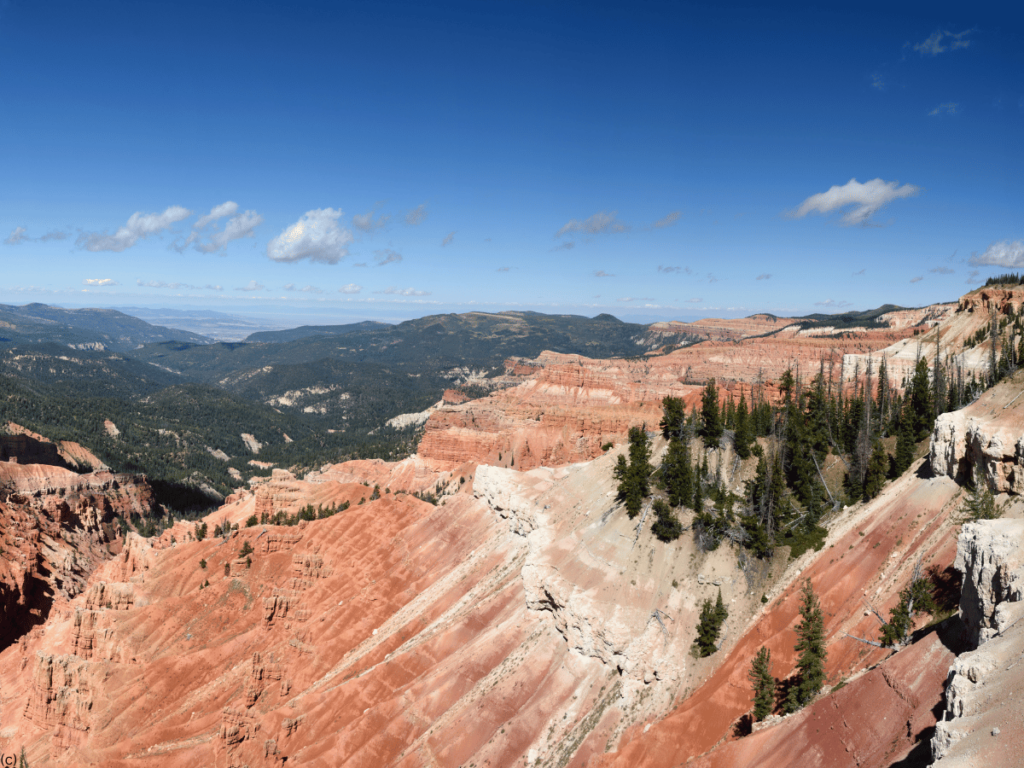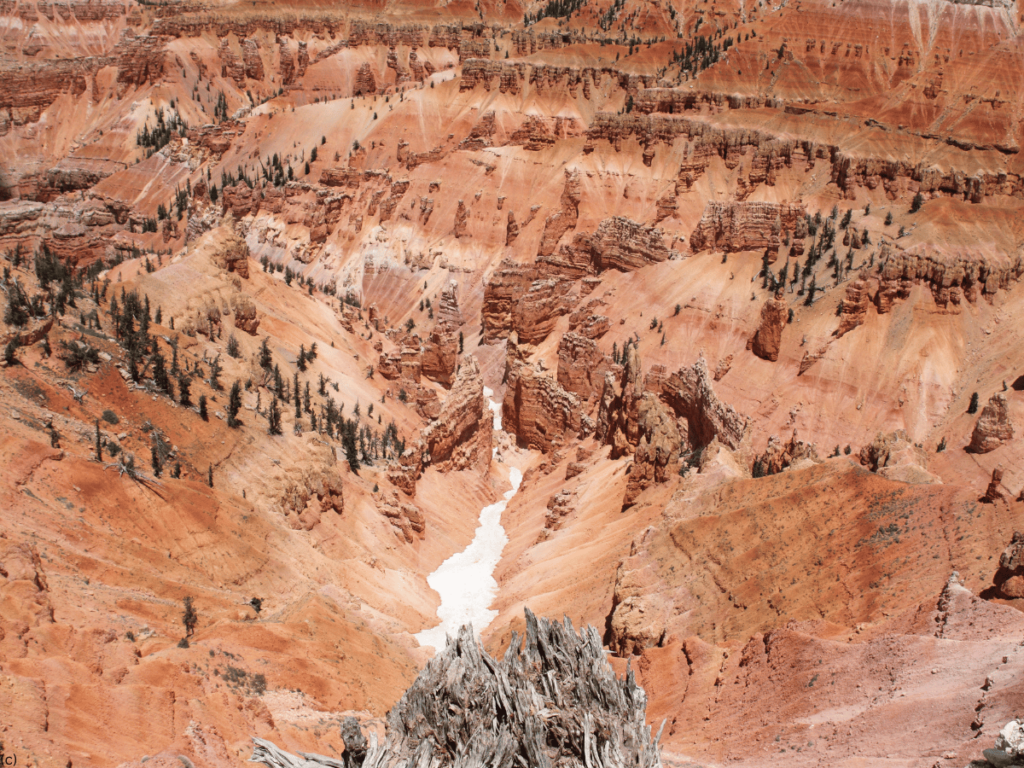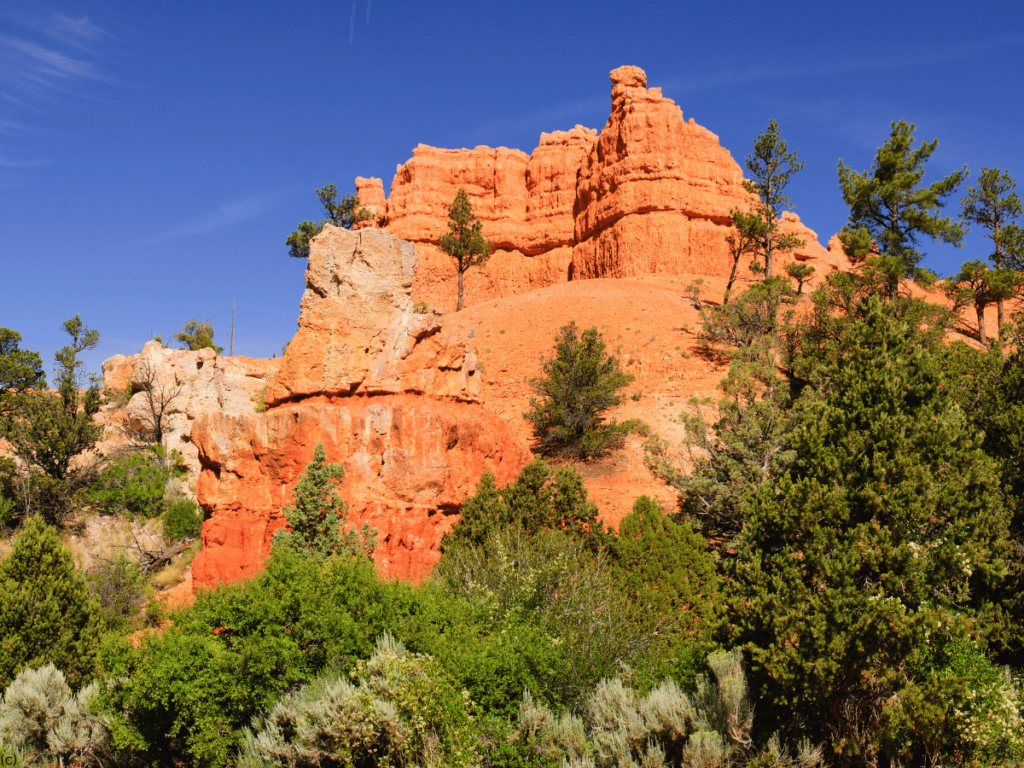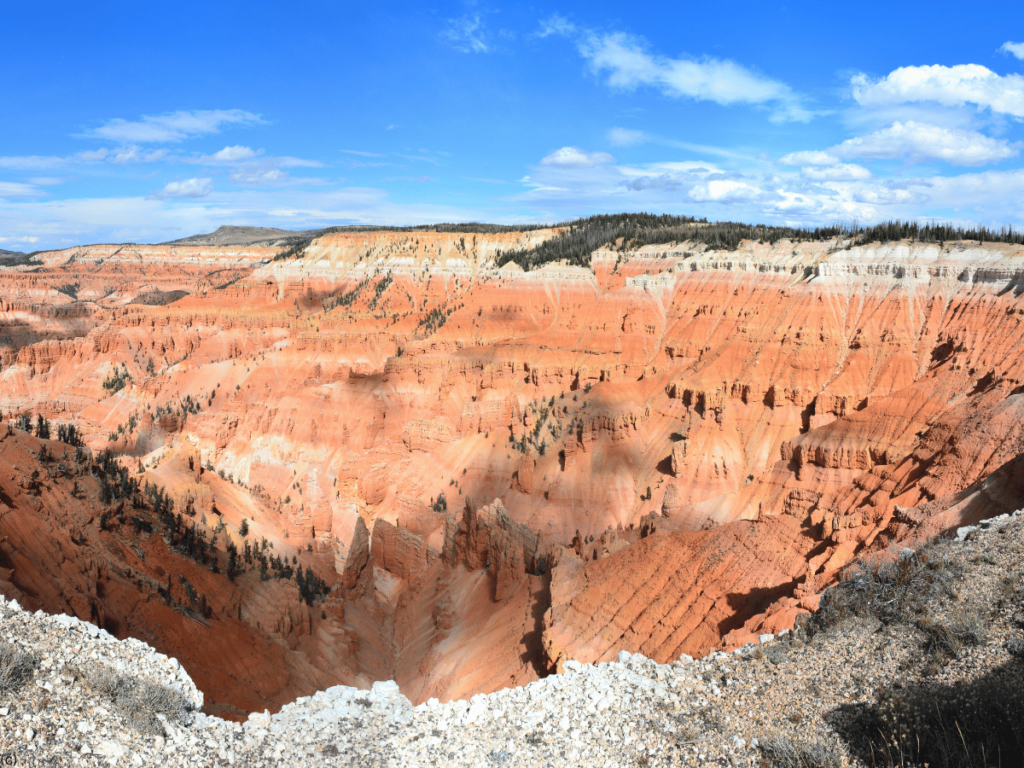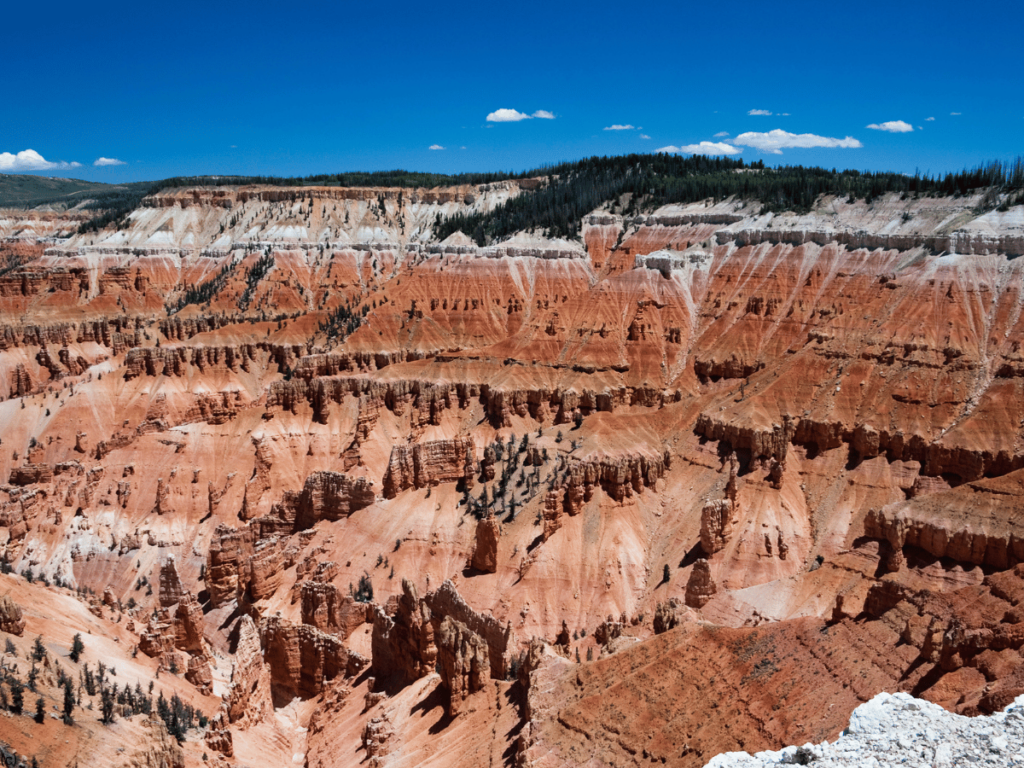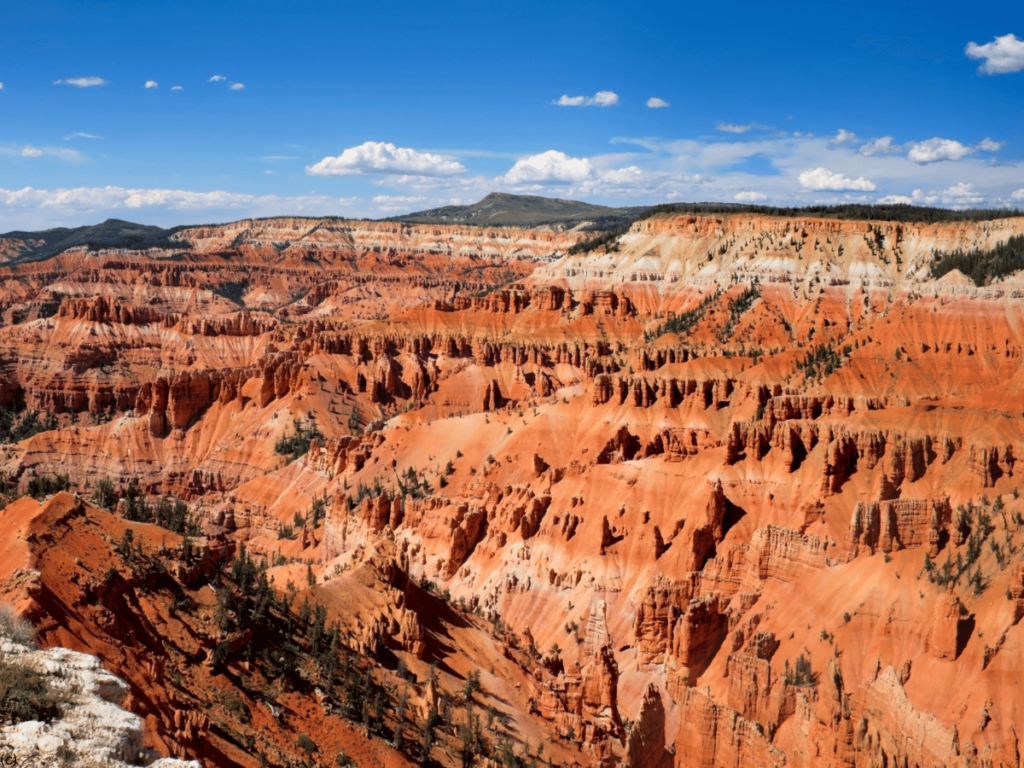
Nestled in the rugged terrain of southern Utah, Cedar Breaks National Monument is a hidden gem often overshadowed by its more famous neighbors like Zion and Bryce Canyon. However, those who venture to this less-traveled destination are rewarded with breathtaking views, vibrant wildflower meadows, and a serene experience that larger parks often lack. At over 10,000 feet above sea level, Cedar Breaks offers a unique combination of geological wonder, rich history, and diverse flora and fauna, making it a must-visit for nature enthusiasts and anyone seeking the beauty of the American West.
The Geology of Cedar Breaks
Cedar Breaks National Monument is often referred to as a “miniature Bryce Canyon,” but this description doesn’t do justice to its unique geological features. The monument’s amphitheater, stretching over three miles wide and plunging 2,500 feet deep, is a stunning display of natural artistry. The vibrant hues of red, orange, and purple rock are the result of millions of years of sedimentation, uplift, and erosion.
The story of Cedar Breaks’ geology begins over 60 million years ago when the area was part of a vast lake. Over time, layers of sediment, including silt, sand, and volcanic ash, settled at the bottom of this lake, forming what we now see as the colorful Claron Formation. As the region underwent tectonic uplift, these sedimentary layers were raised thousands of feet above sea level. Erosion, driven by wind, rain, and ice, sculpted the rock into the intricate formations of hoodoos, fins, and spires that we see today.
One of the most fascinating aspects of Cedar Breaks’ geology is its continued evolution. The forces of nature are still at work, slowly wearing away the rock and reshaping the landscape. This ongoing process makes Cedar Breaks a living monument to the power of geological forces, a place where visitors can witness the Earth’s ever-changing face.
Flora and Fauna: A Biodiversity Hotspot
Cedar Breaks National Monument is not just a geological wonderland; it is also a sanctuary for a diverse array of plant and animal species. The monument’s high elevation and varied terrain create a range of microclimates, each supporting different types of flora and fauna.
Wildflowers and Trees
One of the most remarkable features of Cedar Breaks is its wildflower displays. Every summer, the meadows surrounding the amphitheater come alive with a vibrant array of wildflowers, creating a stunning contrast against the red rock formations. From late June to early September, visitors can witness the bloom of species such as penstemon, paintbrush, and columbine. The monument even hosts an annual Wildflower Festival to celebrate this natural spectacle.
The high elevation also supports a unique assemblage of trees, including ancient bristlecone pines, some of which are over 1,600 years old. These hardy trees, with their gnarled trunks and twisted branches, are a testament to the harsh conditions of life at 10,000 feet. In addition to bristlecones, the monument is home to groves of aspen, spruce, and fir trees, which provide habitat for a variety of wildlife.
Wildlife
Cedar Breaks is a haven for wildlife, with species adapted to the cool temperatures and high altitudes. Mule deer are a common sight, often seen grazing in the meadows or moving through the forests. The area is also home to smaller mammals like marmots, porcupines, and red squirrels.
Birdwatchers will find Cedar Breaks a rewarding destination, with over 100 species of birds recorded in the monument. The Clark’s nutcracker, named after the famous explorer William Clark, is a frequent visitor, known for its role in spreading the seeds of the whitebark pine. Other avian species include mountain bluebirds, Steller’s jays, and golden eagles, which can often be seen soaring above the amphitheater.
Outdoor Activities: Exploring Cedar Breaks
Cedar Breaks National Monument offers a variety of outdoor activities, from hiking and camping to stargazing and photography. Whether you’re a seasoned adventurer or a casual visitor, there’s something here for everyone.
Hiking
Hiking is one of the best ways to experience the natural beauty of Cedar Breaks. The monument features several trails that cater to different skill levels, each offering unique perspectives of the landscape.
- Spectra Point and Ramparts Overlook Trail: This four-mile round-trip hike is one of the most popular in the park. It offers stunning views of the amphitheater and takes hikers through groves of ancient bristlecone pines. The trail is moderately challenging, with some elevation gain, but the breathtaking views make it well worth the effort.
- Alpine Pond Trail: For those seeking a shorter, easier hike, the Alpine Pond Trail is a great option. This two-mile loop takes you through lush meadows and dense forests, with a peaceful alpine pond as the highlight. The trail is family-friendly and provides an excellent opportunity to see wildflowers and wildlife.
- Sunset Trail: This easy, half-mile trail is perfect for a leisurely stroll, offering panoramic views of the amphitheater and the surrounding mountains. It’s a great choice for visitors who want to enjoy the scenery without a strenuous hike.
Camping
For those who want to immerse themselves fully in the beauty of Cedar Breaks, camping is an excellent option. The Point Supreme Campground, located near the visitor center, offers 25 campsites, including some with stunning views of the amphitheater. The campground is open from mid-June to mid-September, weather permitting, and is equipped with basic amenities such as restrooms, picnic tables, and fire pits.
Camping at Cedar Breaks is a unique experience, with cool temperatures even in the height of summer. It’s an ideal spot for stargazing, as the monument is far from city lights and offers some of the darkest skies in the United States. On clear nights, the Milky Way is visible in all its glory, and visitors can often see shooting stars, planets, and even the occasional glimpse of the northern lights.
Winter Activities
While summer is the most popular time to visit Cedar Breaks, the monument also offers a range of winter activities. The high elevation means that snow is common from November through April, transforming the landscape into a winter wonderland.
Snowshoeing and cross-country skiing are popular ways to explore the park in winter. The park’s roads are closed to vehicles during the snowy season, but they become perfect trails for winter sports enthusiasts. The peaceful, snow-covered landscape offers a stark contrast to the busy summer months, making winter a special time to experience the monument.
The annual Winter Festival, held in February, celebrates the season with guided snowshoe hikes, snow sculpting, and other family-friendly activities. It’s a great opportunity to enjoy the park in a different light and experience the tranquility of winter at Cedar Breaks.
The History of Cedar Breaks
The history of Cedar Breaks is as rich and varied as its natural beauty. Long before it was designated a national monument, the area was home to Native American tribes, including the Southern Paiute. These indigenous people lived in harmony with the land, using its resources for sustenance and spiritual practices.
The Southern Paiute people referred to the area as “u-map-wich,” which means “the place where the rocks are sliding down.” This name reflects their deep connection to the land and their understanding of its geological processes. The Paiute people hunted game, gathered wild plants, and used the area’s natural springs for water.
In the 18th century, European explorers and settlers began to move into the region. The first recorded non-native visitor to Cedar Breaks was Silvestre Vélez de Escalante, a Spanish Franciscan missionary, who passed through the area in 1776. However, it wasn’t until the mid-19th century that the area saw significant settlement by pioneers, primarily members of The Church of Jesus Christ of Latter-day Saints (LDS Church). These settlers, drawn by the region’s resources, established communities in the valleys below Cedar Breaks.
In the early 20th century, the scenic beauty of Cedar Breaks caught the attention of conservationists and government officials. In 1933, President Franklin D. Roosevelt designated Cedar Breaks as a national monument, recognizing its unique geological features and natural beauty. Since then, the monument has been protected and preserved, allowing future generations to enjoy its splendor.
Protecting Cedar Breaks: Conservation and Challenges
Like many natural areas, Cedar Breaks faces challenges that threaten its delicate ecosystems and geological features. Climate change, in particular, poses a significant risk to the monument’s flora, fauna, and overall environment.
One of the most pressing concerns is the impact of warming temperatures on the monument’s bristlecone pines. These ancient trees are adapted to cold, high-altitude environments, and as temperatures rise, their habitat is shrinking. The trees are also threatened by an increase in pests, such as bark beetles, which thrive in warmer conditions. Conservation efforts are underway to monitor and protect these trees, but their future remains uncertain.
Another challenge is the increase in visitor numbers. While Cedar Breaks is less crowded than other parks, it has seen a rise in popularity in recent years. This increase in visitation puts pressure on the park’s resources and can lead to issues such as trail erosion, litter, and disturbances to wildlife. The National Park Service is actively working to manage visitor impact through education, trail maintenance, and promoting responsible recreation practices.
Air quality is another concern for Cedar Breaks. The monument is located near several coal-fired power plants, and the resulting pollution can affect both the views and the health of the ecosystem. Efforts are being made to reduce emissions and improve air quality in the region, but it remains an ongoing issue.
Despite these challenges, Cedar Breaks remains a pristine and relatively untouched wilderness. Ongoing conservation efforts, coupled with responsible visitation, are key to ensuring that this incredible landscape is preserved for future generations.
Planning Your Visit to Cedar Breaks
If you’re planning a trip to Cedar Breaks National Monument, there are a few things to keep in mind to make the most of your visit.
When to Visit
The best time to visit Cedar Breaks is during the summer months, from late June to early September. This is when the weather is most favorable, the wildflowers are in bloom, and all the park’s facilities are open. However, be prepared for cool temperatures, even in summer, especially at night.
If you’re interested in winter activities, plan your visit between December and March, when snow is most likely. Keep in mind that winter access is more limited, and you’ll need to be prepared for cold and snowy conditions.
What to Bring
Given the high elevation, it’s important to be prepared for a visit to Cedar Breaks. Here are a few essentials to pack:
- Warm Clothing: Even in summer, temperatures can be chilly, especially in the early morning and evening. Layers are key to staying comfortable.
- Water: The high elevation can lead to dehydration more quickly than at lower altitudes, so bring plenty of water and stay hydrated.
- Sun Protection: The sun can be intense at high altitudes, so bring sunscreen, sunglasses, and a hat.
- Sturdy Footwear: Whether you’re hiking or just walking around the overlooks, sturdy shoes with good traction are essential.
- Camera: With its stunning landscapes, Cedar Breaks is a photographer’s paradise, so don’t forget your camera to capture the beauty.
Getting There
Cedar Breaks is located in southern Utah, about 23 miles east of Cedar City. The monument is accessible via Highway 148, which is open seasonally from late May to mid-October. In winter, the road is closed to vehicles, but the monument can still be accessed by snowmobile, cross-country ski, or snowshoe.
The nearest airport is in Cedar City, which offers regional flights. For those coming from farther away, Las Vegas and Salt Lake City are the closest major airports, both about a three to four-hour drive from the monument.
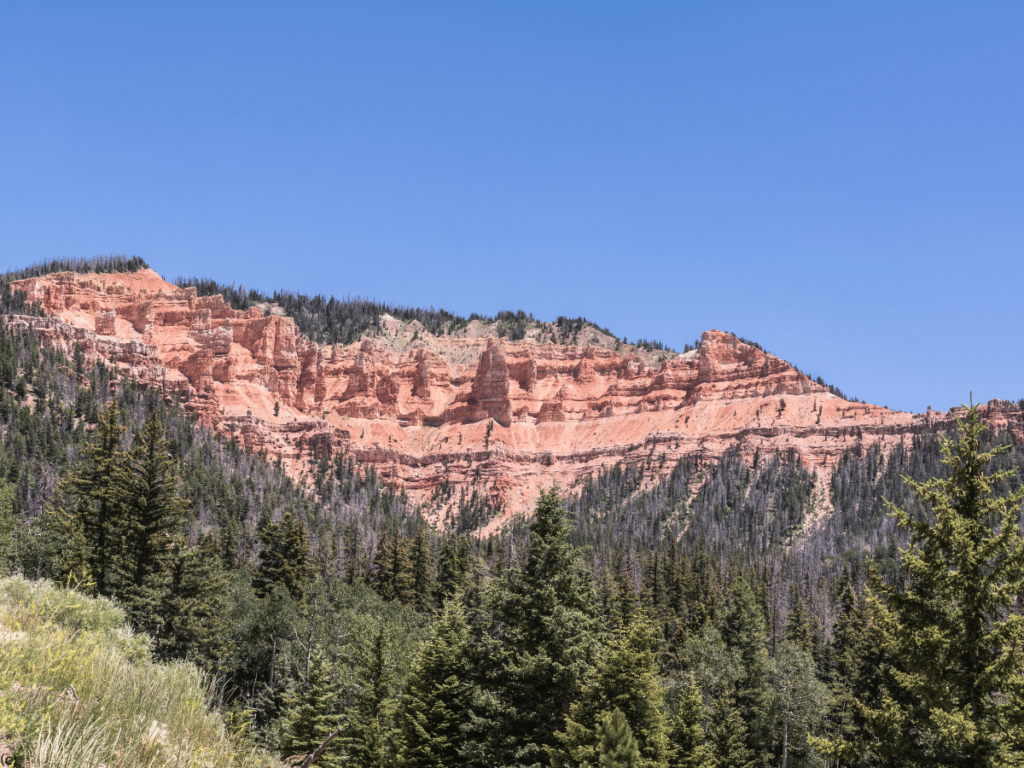
Cedar Breaks National Monument may not have the fame of Utah’s more popular parks, but its unique beauty and tranquil atmosphere make it a destination well worth exploring. Whether you’re drawn by the stunning geology, the vibrant wildflowers, the diverse wildlife, or simply the peace and quiet, Cedar Breaks offers something for everyone. As you stand on the edge of its vast amphitheater, gazing out over the colorful spires and hoodoos, it’s easy to see why this place has captivated visitors for generations.
In an age where many natural areas are becoming increasingly crowded, Cedar Breaks remains a sanctuary of solitude and natural wonder. It is a reminder of the incredible beauty of the American West and the importance of preserving these wild places for future generations. So, if you find yourself in southern Utah, take the time to visit Cedar Breaks. You won’t be disappointed.
